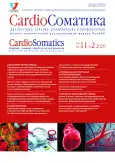Telemetric electrocardiography in diagnostics of cardiotoxic heart rhythm disorders and conductivity in oncologic patients
- Authors: Lyamina N.P.1, Pogonchenkova I.V.1, Lyamina S.V.2
-
Affiliations:
- Moscow Centre for Research and Practice in Medical Rehabilitation, Restorative and Sports Medicine
- Yevdokimov Moscow State University of Medicine and Dentistry
- Issue: Vol 11, No 2 (2020)
- Pages: 16-22
- Section: Original study articles
- URL: https://journals.rcsi.science/2221-7185/article/view/46024
- DOI: https://doi.org/10.26442/22217185.2020.2.200229
- ID: 46024
Cite item
Full Text
Abstract
Aim. Assessment of the possibility to use ECG-telemetry in order to increase the efficiency of cardiotoxic effect diagnosis in cancer patients with chemotherapy.
Material and methods. Remote dynamic monitoring for 6 months was carried out in 31 cardio-oncological patients (in 17 – prostate cancer (PC), in 14 – breast cancer (BC), mean age was 53.6 (50.1; 56.8) years and 48.3 (38.8; 57.1) years, respectively; FC NYHA I–III; left ventricular ejection fraction 47.4% (40.2; 57.3) and 43.2% (39.7; 58.9), respectively; Mini-Mental State Examination from 30 to 24 points – 27.6 (25.4; 29,1) and 28.2 (25.1; 28.8), respectively. ECG-telemetry was performed according to the principle of auto-translation using individual ECG recorders, mobile devices and the ECG Dongle Internet application (Nordavind-Dubna, Russia). Storage, analysis of information and telemedicine consultation was perfomed with the CardioСloud asynchronous tele-cardiological platform. ECG was registered with a frequency of at least 5 times/day and additionally repeatedly in the presence of symptoms and patient desires, duration 10–20 minutes.
Results. Previously undocumented ECG changes were remotely recorded in patients for 6 months of follow-up: in 87.0% of patients – sinus tachycardia, against which ventricular extrasystole of various gradations (32.3%), supraventricular extrasystole (22.6%), transient tachy-dependent blockade of the bundle of His legs were recorded (9.7%). In 64.7% of PC patients and in 42.8% of BC patients rhythm disturbances were detected in combination with depression of the ST segment. Paroxysms of atrial fibrillation were reported in 17.6% of PC patients and in 14.3% BC patients. In 35.5% of patients the detected ECG changes were asymptomatic.
Conclusion. Remote dynamic monitoring in cancer patients receiving chemotherapy involving ECG recording scheme (≥5 times/day, 10–20 min) with ECG telemetry is an effective and unexpensive method for detecting ECG changes in the phenomenon of cardiotoxicity.
Full Text
##article.viewOnOriginalSite##About the authors
Nadezhda P. Lyamina
Moscow Centre for Research and Practice in Medical Rehabilitation, Restorative and Sports Medicine
Author for correspondence.
Email: lyana_n@mail.ru
D. Sci. (Med.), Prof., Moscow Centre for Research and Practice in Medical Rehabilitation, Restorative and Sports Medicine
Russian Federation, MoscowIrena V. Pogonchenkova
Moscow Centre for Research and Practice in Medical Rehabilitation, Restorative and Sports Medicine
Email: lyana_n@mail.ru
D. Sci. (Med.), Moscow Centre for Research and Practice in Medical Rehabilitation, Restorative and Sports Medicine
Russian Federation, MoscowSvetlana V. Lyamina
Yevdokimov Moscow State University of Medicine and Dentistry
Email: lyana_n@mail.ru
D. Sci. (Med.), Prof., Yevdokimov Moscow State University of Medicine and Dentistry
Russian Federation, MoscowReferences
- Bray F et al. Global Cancer Statistics 2018: GLOBOCAN Estimates of Incidence and Mortality Worldwide for 36 Cancers in 185 Countries. Cancer J Clin 2018; 10: 1–31. https://onlinelibrarydddd.wiley.com/doi/full/10.3322/caac.21492
- Zamorano JL, Lancellotti P, Munoz DR et al.; ESC Scientific Document Group. ESC Position Paper on cancer treatments and cardiovascular toxicity developed under the auspices of the ESC Committee for Practice Guidelines: The Task Force for cancer treatments and cardiovascular toxicity of the European Society of Cardiology (ESC). Eur Heart J 2016; 37 (36): 2768–801. doi: 10.1093/eurheartj/ehw211
- Soultati A, Mountzios G, Avgerinou C et al. Endothelial vascular toxicity from chemotherapeu tic agents: Preclinical evidence and clinical implications. Cancer Treatment Rev 2012; 38 (5): 473–83. https://doi.org/10.1016/j
- Lancellotti P, Suter TM, Lopez-Fernandez T. Cardio-Oncology Services: rationale, organization, and implementation. Eur Heart J 2019; 40: 1756–63.
- Snipelisky D, Park JY, Lerman A et al. How to develop a cardio-oncology clinic. Heart Fail Clin 2017; 13: 347–59.
- Kathleen M, Sturgeon A. Population-based study of cardiovascular disease mortality risk in US cancer patients. Eur Heart J 2019; 25 (1–3): ehz766. https://doi.org/10.1093/eurheartj/ehz766
- Floyd JD, Nguyen DT, Lobins RL et al. Cardiotoxicity of cancer therapy. J Clin Oncol 2005; (23): 7685–96. DOI: 10.1200/ JCO.2005.08.78928
- Челобитько Е.Г., Королев С.В., Конов А.В. и др. Тахиаритмии у пациентов с онкологическими заболеваниями. Клиническая практика. 2017; 4: 76–88. [Chelobit’ko E.G., Korolev S.V., Konov A.V. et al. Takhiaritmii u patsientov s onkologicheskimi zabolevaniiami. Klinicheskaia praktika. 2017; 4: 76–88 (in Russian).]
- Folstein MF, Folstein SE, McHugh PR. «Mini-mental state». A practical method for grading the cognitive state of patients for the clinician. J Psychiatric Res 1975; 12 (3): 189–98. doi: 10.1016/0022-3956(75)90026-6
- Лямина Н.П., Котельникова Е.В. Медико-технологические аспекты реабилитационного консультирования с позиций «электронного» здравоохранения. Кардиоваскулярная терапия и профилактика. 2018; 5: 59–64. [Liamina N.P., Kotel’nikova E.V. Mediko-tekhnologicheskie aspekty reabilitatsionnogo konsul’tirovaniia s pozitsii «elektronnogo’ zdravookhraneniia. Kardiovaskuliarnaia terapiia i profilaktika. 2018; 5: 59–64 (in Russian).]
- Steinberg J.S., Varma N., Cygankiewicz I. и др. Cогласованное заключение экспертов ISHNE-HRS 2017 по амбулаторному мониторированию ЭКГ и наружному мониторированию деятельности сердца/телеметрии. Кардиология. 2018; 1: 16–64. [Steinberg J.S., Varma N., Cygankiewicz I. et al. Coglasovannoe zakliuchenie ekspertov ISHNE-HRS 2017 po ambulatornomu monitorirovaniiu EKG i naruzhnomu monitorirovaniiu deiatel’nosti serdtsa/telemetrii. Kardiologiia. 2018; 1: 16–64 (in Russian).]
- Yeh ET, Bickford CL. Cardiovascular complications of cancer therapy: incidence, pathogenesis, diagnosis, and management. J Am Coll Cardiol 2009; 53 (24): 2231–47. https://doi.org/ 10.1016/j.jacc.2009.02.050
Supplementary files







